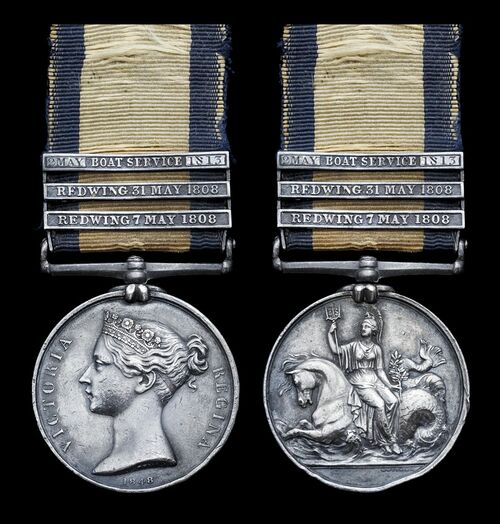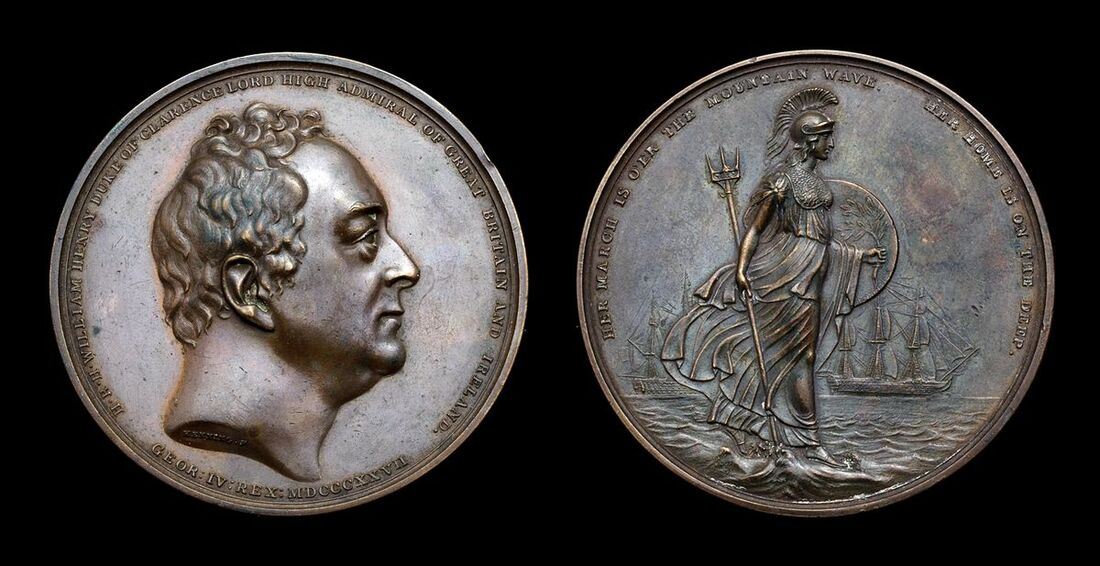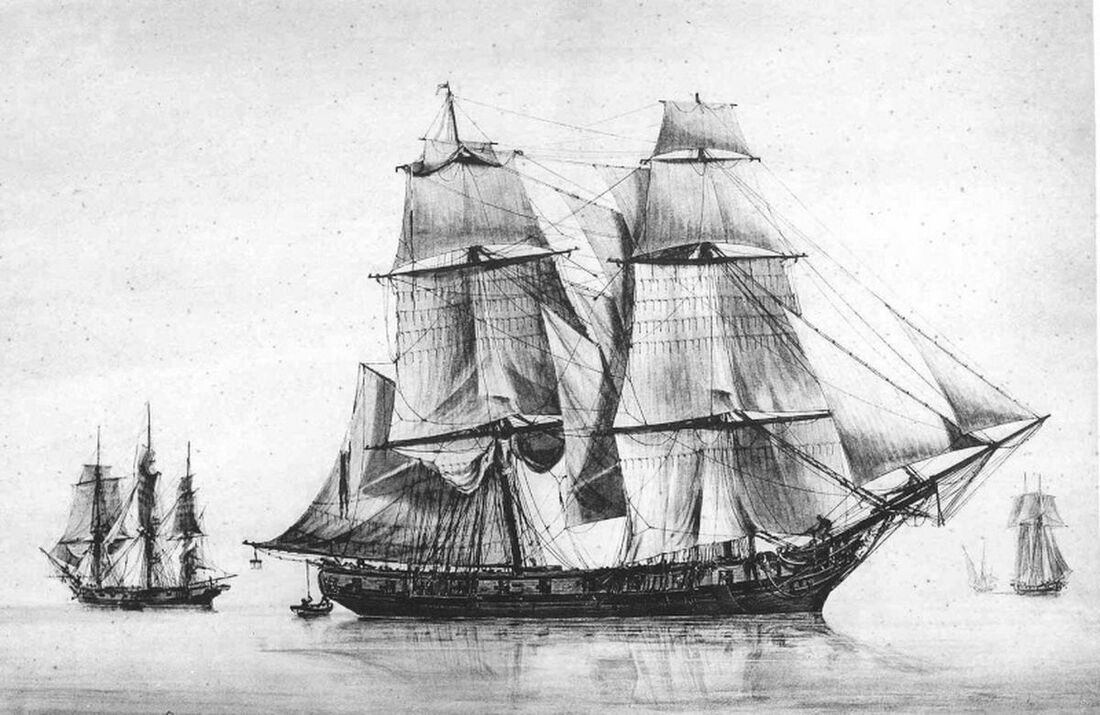Auction: 24002 - Orders, Decorations and Medals
Lot: 5
Sold by Order of a Direct Descendant
The exceptional and unique 3-clasp Naval General Service Medal awarded to Commander T. M. Halahan who, as a young officer, served alongside the renowned Captain Thomas "Undaunted" Ussher aboard H.M.S. Redwing for many of her most notable exploits in the Mediterranean during the Napoleonic Wars, which included single-handed attacks on Spanish convoys at sea and storming shore batteries on land
Naval General Service 1793-1840, 3 clasps, Redwing 7 May 1808, Redwing 31 May 1808, Boat Service 2 May 1813 (Thomas Halahan.), toned, several minor edge knocks, light contact marks to obverse and lightly polished, on its original silk riband, about very fine and rare
Thomas Mahon Halahan is confirmed upon the Medal Roll with correct entitlement to these three clasps, a unique combination for the Naval General Service Medal; sometimes encountered as 'Hallahan', he is also variously noted during his active service as either First-Class Volunteer or Midshipman. The exceptional Orders, Decorations and Medals of his Commanding Officer, Commander Thomas Ussher (later Rear-Admiral Sir Thomas, K.C.H., C.B.) were sold in these Rooms in 2013 for the record breaking sum of £138,000.
Halahan was born circa 1797, one of two sons born to Professor John Halahan and Mary Halahan of Dublin, Ireland, and entered the Royal Navy in 1807 as a First-Class Volunteer aboard the new 18-gun Cruizer-class brig-sloop H.M.S. Redwing, commanded by the dashing and enterprising Commander Thomas Ussher. Commander Ussher had already made a name for himself commanding small vessels in several hard-fought actions, and even undertook a personal reconnaissance of the French fleet at Brest in a 4-oared gig! Halahan would likely have considered himself extremely fortunate to be appointed to such a ship and such a commander for his first taste of naval life.
On 31 January 1807 Ussher, Halahan and the men of H.M.S. Redwing set sail for the Mediterranean. Using Gibraltar as their base of operations, with the mission of protecting British trade and keep the area clear of Spanish vessels, Redwing immediately set to work and, in conjunction with the similarly sized Scout and Morgiana, began harrowing their foe at every opportunity. By July 1807 their work had come to the attention of the Commander-in-Chief Mediterranean (none other than Vice-Admiral Lord Collingwood) who commended their efforts with a 'Mention' in the London Gazette: 'I cannot sufficiently praise the Activity of the Commanders of the Three Brigs, (the Scout, Morgiana, and Redwing,) which have been employed in scouring the Gut of the Enemy; within this Fortnight past they have taken and destroyed Eighteen of the Enemy's Vessels, among which are Two of the Gun Vessels' (London Gazette, 18 July 1807 refers). The previous month, Redwing and Scout had chased a felucca and the Spanish privateer De Bon Vassallio into the River Barbate; the British ships then sent in their boats to board and destroy the privateer, and destroyed two signal posts whilst they were about it. Further notable actions included the capture of the merchant ships Paulina and Twillingen on 22 September and 3 October respectively; advancing into the New Year, on 2 March 1808 Redwing and Confounder captured the American vessel Ocean, and on 12 April similarly captured the Hope. Young Halahan would undoubtedly have shared in these many exciting actions, and along with his shipmates he would be earning a tidy sum in prize money too - but the best was yet to come.
Outnumbered and Outgunned - First Clasp
At daybreak on 7 May 1808, approximately six miles east-south-east of Cape Trafalgar, the lookout aboard Redwing (which was sailing alone rather than in consort) spotted a large convoy of twelve Spanish merchant ships - prime targets for a small and nimble craft like Redwing. The convoy was, however, closely guarded by no less than seven armed vessels: two schooners (the Diligente and Boreas), three gun vessels, a mistico and a felucca. Not only was Ussher outnumbered at least two-to-one (with approximately 270 Spanish sailors against his 120) but his opponents carried guns far heavier than his own, including 24- and 36-pounder pieces: a direct hit at a critical point could instantly disable or even sink Redwing.
In a situation reminiscent of those created by the famous historical novelists C.S. Forester and Patrick O'Brian for their eponymous heroes Horatio Hornblower and Jack Aubrey, the armed Spanish ships formed line abreast and advanced on Redwing with the intention of boarding and capturing this little British ship which had caused so much havoc along their shores. Ussher, meanwhile, had each of his guns (16 32-pounder carronades and two 6-pounder bow guns) loaded with a deadly combination of roundshot, grapeshot, canister, and a bag of 500 musket balls - the perfect mix of projectiles to do the most damage to light craft. As a junior officer, Halahan must have been responsible for overseeing some of these guns, perhaps exchanging a few morale-boosting words with the captain of each piece as they went into action. Though the Spanish opened fire first, they failed to gain crippling hits on Redwing until it was too late: getting in amongst the enemy formation, Ussher gave the order to fire and unleashed a devastating broadside - the Diligente (her first target) lasted but a few seconds, and after giving 'two or three heavy rolls' capsized and sank with all hands. Immediately setting her sights on Boreas, Redwing's veteran crew soon did exactly the same to her too. Upon witnessing this the Spanish ships set sail in flight, with Redwing snapping at their heels: two of the armed vessels and four of the merchantmen ran aground and broke up in the surf, whilst seven of the merchant ships and the mistico were captured - only the felucca, one gunboat and one merchant escaped destruction or capture. Astonishingly, despite the disparity of numbers British casualties had been extremely light: though the large Spanish guns had badly damaged the foremast, they had lost only one man killed, and the Master, Purser, and one sailor wounded. It had been a resounding victory for Ussher, Halahan, and the men of H.M.S. Redwing.
Storming the Guns - Second Clasp
Continuing in her efforts to cause as much mischief to their foe as possible, on 31 May Redwing chased a mistico and two feluccas into the Bay of Bolonia - otherwise known as Tarifa. These vessels took shelter under a shore battery of six long 24-pounders but, in an act which helped lead to his sobriquet, "Undaunted" Ussher took Redwing in to within point-blank range of the battery and actually managed to silence it: naval vessels were always at a great disadvantage in actions such as this, which makes the act even more remarkable. Ordering Lieutenant Ferguson and a party of men to attack the three Spanish ships; under a heavy fire of musketry they destroyed the mistico and captured the feluccas. If that wasn't enough, Ussher then personally led (along with Lieutenant Ferguson) an attack on the battery, spiking the guns and blowing up the magazine before withdrawing 'mission complete'. Again, British casualties had been remarkably low with one man killed and five wounded. Though Halahan's precise role cannot be definitively stated, again as a junior officer amongst a small crew he must have seen his fair share of the fighting. It was for this dashing and gallant affair that Ussher was 'made Post' and promoted to Captain.
Upon promotion, Ussher sailed for home and command of Redwing was given to Commander Edward Augustus Down who inherited a crack ship crewed by seasoned men - including Halahan, who remained aboard despite the change of commanding officer. Down, too, was a fighting captain and continued to add to Redwing's laurels with further small cutting-out actions and captures of small enemy vessels; in August 1812 he was promoted Post-Captain and command was next given to Commander Sir John Gordon Sinclair.
A Return Visit and a Boat Action - Third Clasp
On 2 May 1813, a small squadron of British ships comprising the 74-gun Repulse, Undaunted, Volontaire (both 38), and Redwing were cruising between Marseilles and Toulon when it was noticed that some new shore batteries had been erected in the vicinity - Volontaire, Redwing, and two other vessels had previously attacked this strongpoint on 31 March, destroying the guns, blowing up the ammunition and capturing 11 merchant ships. Captain Mowbray of the Repulse ordered a similar attack, with Redwing giving covering fire and close protection to the boats of the squadron as they went in for the kill. As with the first occasion, this second was also entirely successful with the battery destroyed and six further merchant vessels captured - again, too, the British suffered remarkably low casualties of only two killed and four wounded.
It appears that, shortly after this point, Halahan was reunited with his old chief with a transfer to the 38-gun frigate H.M.S. Undaunted, commanded by Captain Ussher - perhaps Ussher had particularly requested Halahan's transfer both as an old shipmate and someone with a great amount of active service whom he could rely on to do his job well. Fascinatingly, Undaunted (with Ussher still in command) was off the coast of Marseille on the evening of 24 April 1814 when he and Captain Napier of Euryalus noticed illuminations in the town; they were later approached by a boat carrying a white flag, carrying the mayor of the town who informed them of Napoleon Bonaparte's abdication. Upon going ashore, Ussher received a letter from Lord Castlereagh instructing him to convey the former Emperor and his retinue to the island of Elba - two days later, off Frejus, Napoleon boarded the frigate and set off for his new (and brief) home - where they arrived on 30 April. Did Halahan personally witness this small but important occasion in the history of the Napoleonic Wars?
Later Life
Finally promoted Lieutenant on 27 February 1815, sadly Halahan was to see no further active service and advanced through seniority only; returning to his native Ireland, he married Catherine Dufour circa 1821 and for many years afterwards is noted as residing at various addresses around Dublin. As Commander, he died on 24 June 1878 at 'Ranelagh', Rathmines, Dublin and was buried at Mount Jerome cemetery. Interestingly, his brother Robert was killed in action on 12 January 1842 at the Jugdulluck Pass in Afghanistan, whilst serving as an officer in the 44th (East Essex) Regiment of Foot.
Sold together with a bronze medallion, 65mm, commemorating the appointment of H.R.H. The Duke of Clarence as Lord High Admiral of Great Britain and Ireland, privately engraved around the edge 'Lieut. Thos. Halahan. R.N.' in the same style as the Naval General Service Medal.
Subject to 20% VAT on Buyer’s Premium. For more information please view Terms and Conditions for Buyers.
Sold for
£18,000
Starting price
£8000









